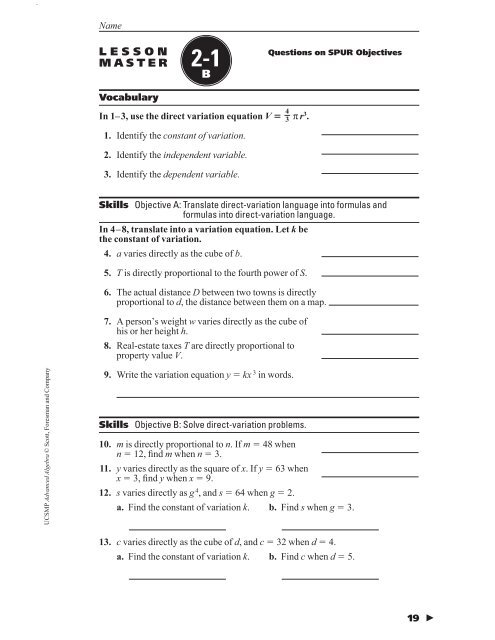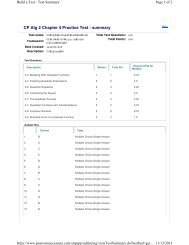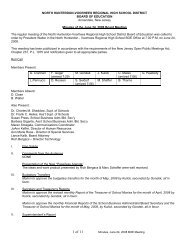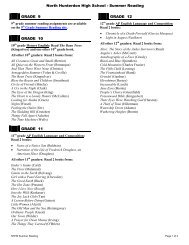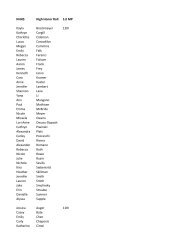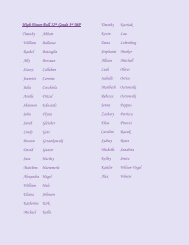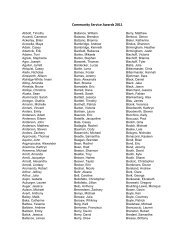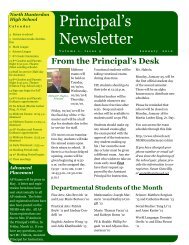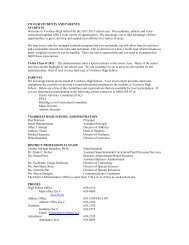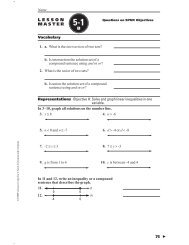You also want an ePaper? Increase the reach of your titles
YUMPU automatically turns print PDFs into web optimized ePapers that Google loves.
UCSMP Advanced Algebra © Scott, Foresman and Company<br />
Name<br />
L E S S O N<br />
M A S T E R<br />
Vocabulary<br />
2-1<br />
B<br />
In 1–3, use the direct variation equation V � π r 3 .<br />
1. Identify the constant of variation.<br />
2. Identify the independent variable.<br />
3. Identify the dependent variable.<br />
Questions on SPUR Objectives<br />
Skills Objective A: Translate direct-variation language into formulas and<br />
formulas into direct-variation language.<br />
In 4–8, translate into a variation equation. Let k be<br />
the constant of variation.<br />
4. a varies directly as the cube of b.<br />
5. T is directly proportional to the fourth power of S.<br />
6. The actual distance D between two towns is directly<br />
proportional to d, the distance between them on a map.<br />
7. A person’s weight w varies directly as the cube of<br />
his or her height h.<br />
8. Real-estate taxes T are directly proportional to<br />
property value V.<br />
9. Write the variation equation y � kx 3 in words.<br />
Skills Objective B: Solve direct-variation problems.<br />
10. m is directly proportional to n. If m � 48 when<br />
n � 12, find m when n � 3.<br />
11. y varies directly as the square of x. If y � 63 when<br />
x � 3, find y when x � 9.<br />
12. s varies directly as g 4 , and s � 64 when g � 2.<br />
a. Find the constant of variation k. b. Find s when g � 3.<br />
13. c varies directly as the cube of d, and c � 32 when d � 4.<br />
a. Find the constant of variation k. b. Find c when d � 5.<br />
4<br />
3<br />
19<br />
�
Name<br />
� LESSON MASTER 2-1B page 2<br />
Uses Objective F: Recognize direct-variation situations.<br />
In 14–16, translate into a variation situation.<br />
14. The price p of a pizza varies directly as the square<br />
of its diameter d.<br />
15. The rebate r is directly proportional to the<br />
number n of coupons submitted.<br />
16. The volume V of a spherical helium balloon is<br />
directly proportional to the cube of its radius r.<br />
Uses Objective G: Solve real-world problems involving direct variation.<br />
17. When lightning strikes 8 miles away, the sound of<br />
the thunder is heard about 40 seconds later. The<br />
time it takes for the sound to travel is directly<br />
proportional to the distance. How long does it take<br />
the sound to travel if lightning strikes 6 miles away?<br />
18. The distance a car travels before stopping after the<br />
driver brakes varies directly as the square of the speed<br />
of the car. If a car travels 30 feet after the driver<br />
brakes when the car’s speed is 20 mph, how far will<br />
the car travel after the driver brakes if the car’s speed<br />
is 60 mph?<br />
19. The designers of the Parthenon, a Greek temple<br />
completed in 432 B.C., utilized the golden ratio. The<br />
outline of its face fits into a golden rectangle, in which<br />
the length varies directly as its height in the ratio 1.618<br />
to 1. The length of the temple was about 31 m. What<br />
was the original height of the Parthenon?<br />
22. The rear wheel of a 5-speed bicycle turns 770 times in a<br />
mile. The table below lists the number of pedal turns<br />
for rear-wheel turns in each gear. The number of rearwheel<br />
turns in each gear is directly proportional to<br />
the number of pedal turns.<br />
20<br />
Gear First Second Third Fourth Fifth<br />
Pedal turns 9 4 1 3 5<br />
Rear-wheel turns 14 7 2 7 14<br />
How many times must a person pedal in a mile in each gear?<br />
a. First b. Second c. Third<br />
d. Fourth e. Fifth<br />
UCSMP Advanced Algebra © Scott, Foresman and Company
UCSMP Advanced Algebra © Scott, Foresman and Company<br />
Name<br />
L E S S O N<br />
M A S T E R<br />
2-2<br />
B<br />
Questions on SPUR Objectives<br />
Skills Objective A: Translate inverse-variation language into formulas and<br />
formulas into inverse-variation language.<br />
In 1–6, translate into a variation equation.<br />
1. P varies inversely with d.<br />
2. e is inversely proportional to the cube of g.<br />
3. m varies inversely with n 2 .<br />
4. The number n of baseballs that can fit into a<br />
carton is inversely proportional to the cube of a<br />
baseball’s radius r.<br />
5. The number of hours h it takes to travel a given<br />
distance varies inversely with the speed s of a car.<br />
6. The weight W of a body varies inversely with the<br />
square of its distance d from the center of the earth.<br />
Skills Objective B: Solve inverse-variation problems.<br />
7. a is inversely proportional to b. If a � 4<br />
when<br />
1<br />
b � 2, find a when b � .<br />
8. y varies inversely as the square of v. If y � 4 when<br />
v � -4, find y when v � 8.<br />
9. m varies inversely as the cube of n. If m � -2 when<br />
n � -5, find m when n � -2.5.<br />
Uses Objective F: Recognize inverse-variation situations.<br />
In 10–15, complete with “directly,” “inversely,” or “neither<br />
directly nor inversely.”<br />
10. The weight of a magazine varies<br />
number of pages it contains.<br />
? as the<br />
11. The speed of a horse varies ? as the time<br />
it takes the horse to travel a given distance.<br />
12. The temperature in Chicago varies<br />
the number of the month of the year.<br />
? with<br />
13. The number of tiles it takes to tile a floor varies<br />
? as the area of the tiles.<br />
2<br />
1<br />
21 �
Name<br />
� LESSON MASTER 2-2B page 2<br />
14. The distance needed to stop a moving vehicle<br />
varies ? as the speed of the vehicle.<br />
15. The amount of sunlight at a given time varies<br />
? as the time of day.<br />
Uses Objective G: Solve real-world problems involving inverse variation.<br />
16. The number n of square tiles needed to tile a floor<br />
varies inversely as the square of the length s of a side<br />
of each tile. If it takes 180 tiles with 6-in. sides to tile<br />
a floor, how many tiles with 9-in. sides will it take to<br />
tile the same floor?<br />
17. The number n of citrus fruit that fit into a carton varies<br />
inversely as the cube of the diameter d of each fruit. A<br />
carton that holds 12 grapefruit with diameter 15 cm<br />
holds how many tangerines with diameter 5 cm?<br />
18. A lever is a simple machine which can<br />
be used to raise a weight at one end of<br />
a bar by pushing down at the other end<br />
of the bar. The diagram at the right shows<br />
how a 3-foot-long crowbar is used to pry<br />
an 80-pound boulder out of the ground.<br />
Recall that the weight needed to balance a<br />
lever is inversely proportional to the<br />
distance of the weight from the fulcrum.<br />
22<br />
a. If the fulcrum is 2 feet from the boulder, how<br />
much weight must be exerted at the other end<br />
of the bar to raise the boulder?<br />
b. Where could the fulcrum be placed in order for<br />
the lever to be more efficient? Justify your answer.<br />
19. It takes 4 workers 6 hours to pick the strawberries in a field.<br />
a. How many hours would it take 6 workers to<br />
pick the strawberries in the same field?<br />
b. What is the constant of variation, and what<br />
does it represent?<br />
UCSMP Advanced Algebra © Scott, Foresman and Company
UCSMP Advanced Algebra © Scott, Foresman and Company<br />
Name<br />
L E S S O N<br />
M A S T E R<br />
Vocabulary<br />
2-3<br />
B<br />
1. If y varies directly as x and x is multiplied<br />
by c, then y is multiplied by ?<br />
.<br />
2. If y varies inversely as x n and x is multiplied<br />
by a nonzero constant c, then y is by cn ? .<br />
Questions on SPUR Objectives<br />
Properties Objective D: Use the Fundamental Theorem of Variation.<br />
In 3–6, suppose that in a variation problem the value<br />
of x is doubled. How is the value of y changed<br />
3. if y varies directly as x 3 ?<br />
4. if y varies directly as x 4 ?<br />
5. if y varies inversely as x 2 ?<br />
6. if y varies inversely as √x?<br />
In 7–9, suppose that a varies directly as the fourth<br />
power of b. How does the value of a change if<br />
7. b is doubled?<br />
8. b is multiplied by 5?<br />
9. b is multiplied by ?<br />
In 10–12, suppose that m varies inversely as the square<br />
root of n. How does the value of m change if<br />
10. n is doubled?<br />
11. n is multiplied by 4?<br />
12. n is multiplied by ?<br />
In 13–15, tell what effect multiplying the x-values by<br />
has on the y values.<br />
13. y � 5x<br />
14. y � 4x 2<br />
15. y � 8 x<br />
1<br />
4<br />
1<br />
9<br />
1<br />
3<br />
23 �
Name<br />
� LESSON MASTER 2-3B page 2<br />
Review Previous course<br />
In 16–21, graph the equation.<br />
16. 4x � 3y � 24 17. y � x � 6<br />
18. xy � 12 19. y � x 2<br />
20. y � 2 x 21. y � 1<br />
x<br />
y<br />
24<br />
-5<br />
-5<br />
-5<br />
y<br />
5<br />
-5<br />
y<br />
5<br />
-5<br />
5<br />
-5<br />
5<br />
5<br />
5<br />
x<br />
x<br />
x<br />
1<br />
2<br />
-5<br />
-5<br />
-5<br />
y<br />
5<br />
-5<br />
y<br />
5<br />
-5<br />
y<br />
5<br />
-5<br />
5<br />
5<br />
5<br />
x<br />
x<br />
x<br />
UCSMP Advanced Algebra © Scott, Foresman and Company
UCSMP Advanced Algebra © Scott, Foresman and Company<br />
Name<br />
L E S S O N<br />
M A S T E R<br />
Vocabulary<br />
2-4<br />
B<br />
1. Slope measures the ? of a line.<br />
Questions on SPUR Objectives<br />
2. Multiple choice. Tell which of the following<br />
is not a definition of slope.<br />
(a) the rate of change of<br />
y with respect to x<br />
(b)<br />
change in vertical distance<br />
change in horizontal distance<br />
change in independent variable<br />
(c) (d)<br />
change in dependent variable<br />
Skills Objective C: Find slopes.<br />
In 3–5 find the slope of the line through the given points.<br />
3. (5, -2), (3, 8) 4. (-9, 2), (-4, 0) 5. (12, 8), (6, -3)<br />
6. Find the slope of each line<br />
graphed at the right.<br />
a.<br />
b.<br />
c.<br />
Representations Objective E: Identify properties of variation functions.<br />
In 7–9, give the slope of the line which is the<br />
graph of the equation.<br />
rise<br />
run<br />
1<br />
7. y � -7x 8. y � 2 x 9. y � 0.2x<br />
a.<br />
c.<br />
y<br />
b.<br />
x<br />
25 �
Name<br />
� LESSON MASTER 2-4B page 2<br />
Uses Objective I: Graph variation equations<br />
In 10–13, graph the equation.<br />
10. y � -2x 11. y � 4 x<br />
y<br />
12. y � 1.5x 13. y � 3x<br />
y<br />
Representations Objective J: Identify variation equations from their graphs.<br />
14. Match each graph with its equation. The axes have the same scale.<br />
26<br />
i. y � 5x ii. y � -5x iii. y � x iv. y � - x<br />
a. b.<br />
y<br />
x<br />
c. d.<br />
y<br />
x<br />
x<br />
x<br />
3<br />
4<br />
1<br />
y<br />
y<br />
y<br />
y<br />
x<br />
x<br />
3<br />
4<br />
x<br />
x<br />
UCSMP Advanced Algebra © Scott, Foresman and Company
UCSMP Advanced Algebra © Scott, Foresman and Company<br />
Name<br />
L E S S O N<br />
M A S T E R<br />
Vocabulary<br />
2-5<br />
B<br />
1. A graph symmetric to the y-axis coincides<br />
with its ? image over the y-axis.<br />
Questions on SPUR Objectives<br />
2. Multiple choice. The graph of which equation is a parabola?<br />
(a) y � x 3 (b) y � 2 x (c) y � 2x 2<br />
Skills Objective C: Find rates of change.<br />
In 3 and 4, y � 6x 2 .<br />
3. Find the rate of change between x � 2 and x � 5.<br />
4. Find the rate of change between x � -2 and x � 2.<br />
In 5 and 6, y � -2 x 2 .<br />
5. Find the rate of change between x � 4 and x � 6.<br />
6. Find the rate of change between x � 6 and x � 8.<br />
Properties Objective E: Identify properties of graphs of functions<br />
with equations of the form y � kx 2 .<br />
In 7–9, refer to the following equations.<br />
(a) y � -4x (b) y � x (c) y � -4x 2 (d) y � x 2<br />
7. Which equations have a graph which is a parabola?<br />
8. Which equations have a graph which is symmetric<br />
with respect to the y-axis?<br />
9. Which equations have a straight-line graph?<br />
Uses Objective I: Graph equations of the form y � kx 2 .<br />
In 10 and 11, graph the equations on the same grid. Label the graphs.<br />
10. a. y � 5x 2 b. y � -5x 2 11. a. y � x 2 b. y � - x 2<br />
a.<br />
-5<br />
5<br />
-5<br />
y<br />
5<br />
b.<br />
x<br />
1<br />
4<br />
a.<br />
-5<br />
1<br />
2<br />
y<br />
5<br />
-5<br />
5<br />
b.<br />
1<br />
4<br />
x<br />
1<br />
2<br />
27 �
Name<br />
� LESSON MASTER 2-5B page 2<br />
Representations Objective J: Identify variation equations from<br />
their graphs.<br />
12. Match each graph with its equation. Axes have the same scale.<br />
28<br />
i. y � -3x ii. y � x 2 iii. y � 3x 2 iv. y � - x 2<br />
a. b. c.<br />
y<br />
y<br />
Representations Objective K: Recognize the effects of a change<br />
in scale or viewing window on a graph of a<br />
variation equation.<br />
13. In the graph of y � kx 2 shown at the right,<br />
what type of number is k?<br />
14. a. Sketch the graph of y � 2x � 1<br />
on the window at the right.<br />
b. Sketch the graph of y � 2x � 1 on<br />
the second window at the right.<br />
x<br />
1<br />
3<br />
c. Does the slope of the line<br />
y � 2x � 1 change when the<br />
viewing window is changed?<br />
Explain your answer.<br />
a.<br />
b.<br />
x<br />
y<br />
1<br />
3<br />
y<br />
-2 ≤ x ≤ 2, x-scale � 1<br />
-5 ≤ y ≤ 5, y-scale � 1<br />
-2 ≤ x ≤ 2, x-scale � 1<br />
-10 ≤ y ≤ 10, y-scale � 1<br />
x<br />
x<br />
UCSMP Advanced Algebra © Scott, Foresman and Company
UCSMP Advanced Algebra © Scott, Foresman and Company<br />
Name<br />
L E S S O N<br />
M A S T E R<br />
Vocabulary<br />
2-6<br />
B<br />
Questions on SPUR Objectives<br />
1. Multiple choice. Which is an equation for a hyperbola?<br />
(a) y � (b) y � (c) y � 2x (d) y �<br />
2. The parts of a hyperbola are called .<br />
2<br />
3. Name the asymptotes of the graph of<br />
x<br />
. 2<br />
2<br />
x<br />
x<br />
2<br />
?<br />
Skills Objective C: Find rates of change.<br />
In 4–7, find the rate of change between -2 and 2.<br />
8<br />
4. y �<br />
x<br />
5. y �<br />
8<br />
6. y � - 7. y � -<br />
x2 8<br />
x<br />
Properties Objective E: Identify properties of variation functions.<br />
8. True or false Graphs of all variation functions<br />
pass through the point (0, 0).<br />
In 9–12, refer to these equations.<br />
(a) y � kx (b) y � (c) y � kx 2 k<br />
x<br />
(d) y �<br />
9. Which graphs have exactly one line of symmetry?<br />
10. Which graphs have more than one part?<br />
11. When k < 0, which graphs have points in the<br />
fourth quadrant?<br />
12. When k > 0, which graphs have points in the<br />
third quadrant?<br />
8<br />
x 2<br />
2<br />
x 2<br />
k<br />
x 2<br />
29 �
Name<br />
� LESSON MASTER 2-6B page 2<br />
Uses Objective I: Graph inverse-linear variation and inversesquare<br />
variation equations.<br />
In 13–16, graph the equation.<br />
8<br />
13. y �<br />
x<br />
y<br />
14. y � - 8<br />
x<br />
15. y � 16. y � - 8<br />
x2 8<br />
x2 y<br />
Representations Objective J: Identify inverse-linear and inversesquare<br />
functions from their graphs.<br />
In 17–19, multiple choice. Choose the equation whose graph is<br />
most like that shown. Assume that the axes have the same scale.<br />
17. 18. 19.<br />
y<br />
y<br />
(a) y � - (a) y � 2x 2 3<br />
x<br />
(a) y �<br />
(b) y � 3x 2 (b) y � -2x 2 (b) y � -7x 2<br />
(c) y � - (c) y � (c) y � -<br />
(d) y � (d) y � (d) y � 7x 2<br />
7<br />
x<br />
3<br />
x<br />
2<br />
x<br />
2<br />
2<br />
x2 3<br />
x2 30<br />
-5<br />
-5<br />
x<br />
5<br />
-5<br />
5<br />
-5<br />
5<br />
5<br />
x<br />
x<br />
x<br />
-5<br />
-5<br />
-5<br />
y<br />
5<br />
-5<br />
y<br />
5<br />
y<br />
7<br />
x 2<br />
5<br />
5<br />
x<br />
x<br />
x<br />
UCSMP Advanced Algebra © Scott, Foresman and Company
UCSMP Advanced Algebra © Scott, Foresman and Company<br />
Name<br />
L E S S O N<br />
M A S T E R<br />
2-7<br />
B<br />
Questions on SPUR Objectives<br />
Uses Objective H: Fit an appropriate variation model to data.<br />
In 1 and 2, multiple choice. Tell which equation is the<br />
best model for the graph shown at the left.<br />
1. y<br />
(a) y � kx<br />
(b) y � kx 2<br />
(c) y �<br />
(d) y �<br />
2. y<br />
(a) y � kx<br />
(b) y � kx 2<br />
(c) y �<br />
(d) y �<br />
In 3–6, do steps a through d.<br />
a. Draw a graph to represent the situation.<br />
b. Write a general variation equation for the situation.<br />
c. Find the value of the constant of variation and rewrite<br />
the variation equation.<br />
d. Answer the question in the problem.<br />
3. The amount of force needed to loosen a certain bolt is<br />
related to the length of a wrench as given in the table.<br />
a.<br />
Force needed (lb) 3 7 10 15 30<br />
Length of wrench (in.) 630 270 189 126 63<br />
How many pounds of force would be needed to loosen the<br />
same bolt with a 21-inch wrench?<br />
F<br />
600<br />
500<br />
400<br />
300<br />
200<br />
100<br />
4<br />
x<br />
8 12 16 20 24 28<br />
x<br />
L<br />
b.<br />
c.<br />
d.<br />
k<br />
x2 k<br />
x<br />
k<br />
x2 k<br />
x<br />
31 �
Name<br />
� LESSON MASTER 2-7B page 2<br />
4. While studying gears, a physics class<br />
collected the data in the table<br />
relating the number of teeth in a gear<br />
and the speed of the gear in revolutions<br />
per minute. What would be the speed<br />
of a gear with 30 teeth?<br />
a.<br />
5. The table to the right gives the<br />
number of square tiles of various<br />
sizes needed to floor a small<br />
restaurant kitchen. How many<br />
square tiles with 8-in. sides<br />
would be needed?<br />
a.<br />
6. A packaging specialist studied the weights of 100 ball<br />
bearings of various diameters. The data are in the table.<br />
a.<br />
32<br />
S<br />
100<br />
80<br />
60<br />
40<br />
20<br />
N<br />
2000<br />
1000<br />
Diameter of bearing (mm) 3 4 5 6 7 8<br />
Weight of 100 bearings (grams) 12 28 54 93 147 220<br />
Number of teeth 10 12 18 24 36<br />
Speed (rpm) 108 90 60 45 30<br />
What would be the weight of 100 ball bearings with 10-mm diameters?<br />
W<br />
200<br />
100<br />
6 12 18 24 30 36<br />
4 8 12<br />
T<br />
2 4 6 8 10<br />
D<br />
L<br />
b.<br />
c.<br />
d.<br />
Length of tile side 4 in. 6 in. 9 in. 12 in.<br />
Number of tiles 1944 864 384 216<br />
b.<br />
c.<br />
d.<br />
b.<br />
c.<br />
d.<br />
UCSMP Advanced Algebra © Scott, Foresman and Company
UCSMPAdvancedAlgebra © Scott, Foresman and Company<br />
Name<br />
L E S S O N<br />
M A S T E R<br />
Uses Objective H<br />
2-8<br />
A<br />
Questions on SPUR Objectives<br />
See pages 134–137 for objectives.<br />
1. An automotive engineer performed tests on a new tire to find the relationship<br />
between the air pressure P in pounds per square inch, the volume V in cubic<br />
inches, and the temperature T in degrees Kelvin. The engineer obtained the<br />
graph on the left by measuring pressure and volume when the temperature was<br />
280˚K. The graph on the right was obtained by measuring the pressure and<br />
the temperature when the volume was 2200 in3 .<br />
P<br />
P<br />
20<br />
10<br />
1000 2000 3000<br />
Write an equation relating P,V, and T. Do<br />
not find the constant of variation.<br />
2. Jeremy and Jenny performed an experiment to discover the relationship<br />
between the power of an electric light and the resistance in the circuit and the<br />
voltage supplied. They first collected the following data relating the power P<br />
and the resistance R on circuits with 2 volts.<br />
I. Resistance (ohms) 50 100 150 200 250<br />
Then they collected data when II.<br />
the resistance in the circuit was<br />
200 ohms. These data relate the<br />
powerPand the voltage V.<br />
a. Graph the points from Table I. b. Graph the points from Table II.<br />
P<br />
P<br />
1000<br />
800<br />
600<br />
400<br />
200<br />
Power (watts) 800 400 267 200 160<br />
100 200 300<br />
c. How does P vary with R? d. How does P vary with V?<br />
e. Use the Converse of the Fundamental Theorem<br />
of Variation to write an equation relating P,R,<br />
andV. Do not find the constant of variation.<br />
V<br />
R<br />
30<br />
20<br />
10<br />
1250<br />
1000<br />
750<br />
500<br />
250<br />
100 200 300<br />
Voltage (volts) 1 2 3 4 5<br />
Power (watts) 50 200 450 800 1250<br />
2 4 6<br />
T<br />
V<br />
23
Name<br />
L E S S O N<br />
M A S T E R<br />
Skills Objective A<br />
In 1 and 2, translate into a variation equation.<br />
1. The volume V of a rectangular prism varies jointly<br />
as its length L, its width W, and its height H.<br />
2. R varies directly as the square of P, directly as L,<br />
and inversely as the square root of A.<br />
In 3 and 4, write each variation equation in words.<br />
3. P �kIRT<br />
4. E �<br />
24<br />
2(V 1 �V 0 )<br />
X<br />
Skills Objective B<br />
5. w varies directly as the square of x and<br />
inversely as y. When x � 5 and y� 2,<br />
w � 23.75. Find w whenx�-3 and y � -6.<br />
6. z varies jointly as the square root of x and<br />
the cube of y. When x � 9 and y � 2,<br />
z � 4. Find z whenx�25 and y � -5.<br />
Uses Objective G<br />
2-9<br />
A<br />
7. The amount that a piece of copper wire 50 ft long<br />
stretches varies directly as the force applied to it and<br />
inversely as the cross-sectional area of the wire. When<br />
a 250-lb force is applied to a wire with cross-sectional<br />
area 0.0032 in 2 , the wire stretches 1.08 in. How<br />
far would the wire stretch if a force of 300 lb were<br />
applied to a wire of cross-sectional area 0.005 in 2 ?<br />
8. The kinetic energy of an object varies jointly as its<br />
mass and the square of its velocity. The kinetic energy<br />
of an object with mass 12 kg moving at 8 m/s is<br />
384 joules. Find the kinetic energy of an object<br />
with mass 8 kg moving at 12 m/s.<br />
Questions on SPUR Objectives<br />
See pages 134–137 for objectives.<br />
UCSMPAdvancedAlgebra © Scott, Foresman and Company


